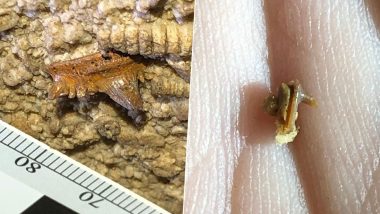Scientists have discovered a fossilised shark head dating back to some 300 million years ago in a Kentucky cave. It was found inside the Mammoth Cave National Park located in Kentucky, the Earth's oldest known cave system. Experts have identified the remains of 15 to 20 different species of sharks deep in the cave with its head protruding from the wall. According to experts, it lived between 340 and 330 million years ago during the Late Mississippian geological period. The preserved head shows its skull, lower jaw, cartilage and teeth. Looking at the dimensions it seems that the animal was similar to the size of our Great White Shark. 'Dancing Dragon' Feather Dinosaur Fossil Living 120 Million Years Ago Uncovered in China, View Pics.
Rick Olson and Rick Toomey first came across the remains while mapping the world’s longest cave system, the 400-mile Mammoth Cave National Park, according to to the Louisville Courier Journal. Mammoth Cave specialists Rick Olson and Rick Toomey first spotted the fossils and tried to identify it. It was palaeontologist John-Paul Hodnett who discovered the fossils. More than 100 shark species have been discovered at the Mammoth Cave National Park. Teeth and dorsal fins of sharks can be seen in the cave ceilings and walls. New Species of 'Sexy Dinosaurs' From 140 Million Years Ago Discovered in Patagonia, View Pic!
Tooth of The Shark!
Hodnett is studying the fossil specimens he has collected from the cave and estimates that he's found the fossils of about 150 different sharks from 15 to 20 different species.
Shark Teeth Being Collected in Dustpans:
View this post on Instagram
From the ceilings to the walls, we use dust pans to catch the shark teeth that falls!
Fossil Shark Remains!
Hodnett told CNN, "There's hardly ever any record at all of sharks teeth coming from these rocks. So that was exciting. So this is a brand new record of sharks from a particular layer of time. It's super exciting, but not exactly the easiest thing to study. Caves are a very special environment, so it's not ideal to be removing big chunks of rock out of it and damage the internal environment by doing this. It's gonna be very hard to bring the appropriate equipment in there to properly excavate the specimen out of the cave."
(The above story first appeared on LatestLY on Jan 31, 2020 11:58 AM IST. For more news and updates on politics, world, sports, entertainment and lifestyle, log on to our website latestly.com).













 Quickly
Quickly




















